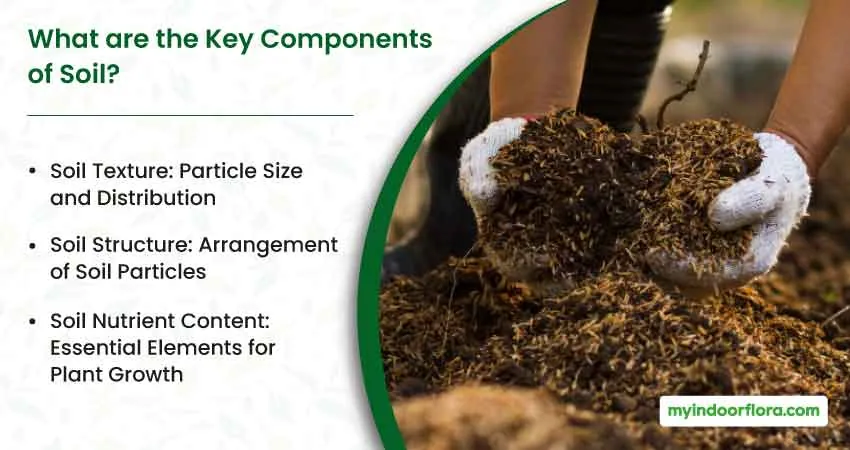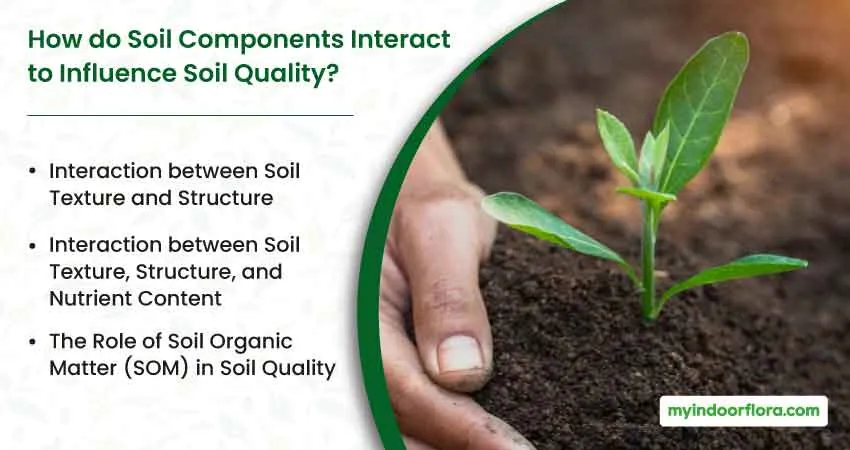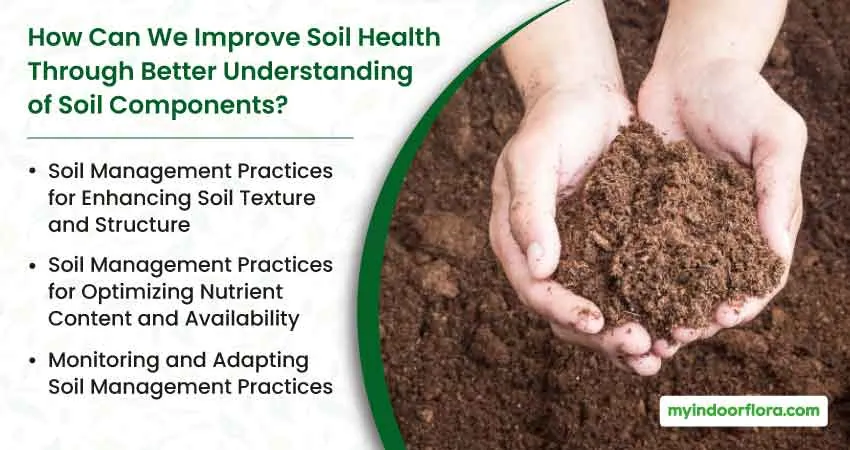Soil, the complex and dynamic medium that supports life on Earth, plays a crucial role in agriculture, ecology, and environmental management. According to the Food and Agriculture Organization (FAO), around 95% of our food comes directly or indirectly from soil, highlighting its significance in global food security.
Understanding the key components of soil – texture, structure, and nutrient content – is essential for maintaining soil health and productivity. A study published in the journal Nature Sustainability emphasizes the importance of managing these components to achieve sustainable agricultural practices and protect ecosystem services.
In this article, we explore the critical aspects of soil, exploring their characteristics, interactions, and impact on overall soil quality. We also discuss practical and actionable tips backed by scientific research to improve soil health, ensuring sustainable agriculture and environmental stewardship.
What are the Key Components of Soil?

To gain a holistic understanding of soil, we must first examine its key components. In this section, we discuss soil texture, structure, and nutrient content, exploring the characteristics that define them and their importance in determining soil health.
Soil Texture: Particle Size and Distribution
Soil texture is a fundamental attribute that influences various soil properties. It is determined by the size and distribution of individual soil particles, which can be classified into three main categories: sand, silt, and clay.
1. What are the Different Soil Particles?
- Sand: Ranging in size from 0.05 to 2 mm, sand particles are the largest and have a gritty texture. They are primarily composed of weathered rock and mineral fragments.
- Silt: Silt particles are finer than sand, with sizes between 0.002 and 0.05 mm. They have a smooth texture and are composed of mineral particles and fine organic matter.
- Clay: The smallest of the three, clay particles are less than 0.002 mm in size. They have a sticky texture when wet and are composed of microscopic mineral particles, such as silicates and aluminum oxide.
2. How is Soil Texture Determined?
Soil texture is typically determined using the soil textural triangle, a graphical representation that classifies soils based on their relative proportions of sand, silt, and clay. Field methods, such as the ribbon or feel method, can also be employed to estimate soil texture. In the laboratory, soil texture can be determined using a combination of sieving and sedimentation techniques.
3. Why is Soil Texture Important?
Soil texture has a significant impact on a variety of soil properties, including:
- Water-holding capacity: Finer-textured soils (with higher clay and silt content) can hold more water than coarser-textured soils (with higher sand content).
- Nutrient availability: Soil texture affects the soil’s ability to retain and release nutrients. Finer-textured soils generally have a higher nutrient-holding capacity.
- Erosion potential: Coarser-textured soils are more prone to erosion due to their larger particle size and lower water-holding capacity.
Soil Structure: Arrangement of Soil Particles
While soil texture focuses on the size and distribution of individual particles, soil structure describes the arrangement of these particles and the spaces between them. Soil structure has a significant impact on root penetration, water infiltration, and aeration.
1. What are the Different Types of Soil Structure?
Soil structure can be classified into four main types:
- Granular: Small, rounded aggregates that are loosely packed and allow for good water infiltration and aeration. This structure is common in the topsoil of well-managed soils and is ideal for plant growth.
- Blocky: Soil particles are arranged into larger, angular aggregates that can impede water movement and root penetration. This structure is often found in subsoil layers and can be the result of compaction or clay-rich soils.
- Platy: Soil particles form thin, horizontal layers that can impede water movement and aeration. Platy structures are typically found in compacted or poorly drained soils.
- Prismatic: Soil particles form vertical, columnar aggregates with distinct vertical faces. Prismatic structures are common in subsoil layers with high clay content and can also impede water movement and root penetration.
2. How is Soil Structure Formed?
Soil structure is influenced by a combination of factors, including:
- Soil-forming factors: Climate, parent material, topography, biological activity, and time all contribute to the development of soil structure.
- Soil biological activity: Earthworms, fungi, bacteria, and plant roots all play a role in shaping soil structure through their burrowing, decomposition, and secretion of sticky substances that bind soil particles together.
3. Why is Soil Structure Important?
Soil structure has a direct impact on various aspects of soil health, such as:
- Root penetration: A well-structured soil allows for easier root penetration, promoting plant growth and access to water and nutrients.
- Water infiltration and drainage: Good soil structure promotes water infiltration and drainage, reducing the risk of waterlogging and improving aeration.
- Aeration: A well-aerated soil provides oxygen to plant roots and soil organisms, supporting their growth and metabolism.
Soil Nutrient Content: Essential Elements for Plant Growth
Soil nutrient content refers to the presence and availability of essential elements required for plant growth. These elements can be classified into primary macronutrients, secondary macronutrients, and micronutrients.
1. What are the Primary Macronutrients in Soil?
The primary macronutrients, required in large quantities by plants, include Nitrogen, Phosphorus, and Potassium.
- Nitrogen (N): Essential for protein synthesis and chlorophyll production, nitrogen promotes vegetative growth and is a key component of amino acids, nucleic acids, and other cellular structures.
- Phosphorus (P): Important for energy transfer, root development, and flowering, phosphorus is a component of ATP, nucleic acids, and phospholipids.
- Potassium (K): Playing a crucial role in regulating water movement, enzyme activation, and protein synthesis, potassium also helps strengthen cell walls and supports fruit and seed development.
2. What are the Secondary Macronutrients and Micronutrients in Soil?
In addition to the primary macronutrients, plants also require secondary macronutrients and micronutrients, albeit in smaller quantities:
- Secondary macronutrients: Calcium (Ca), Magnesium (Mg), and Sulfur (S) play important roles in plant growth and development, such as cell wall formation, enzyme activation, and synthesis of essential compounds.
- Micronutrients: Iron (Fe), Manganese (Mn), Zinc (Zn), Copper (Cu), Boron (B), Molybdenum (Mo), and Chlorine (Cl) are required in trace amounts but are essential for various plant functions, such as enzyme activation, photosynthesis, and hormone regulation.
3. How are Nutrient Availability and Soil Fertility Assessed?
Soil testing is a crucial tool for assessing nutrient availability and soil fertility. By analyzing soil samples, laboratories can provide valuable information on the levels of available nutrients and the soil’s pH, which influences nutrient availability. Soil test results can then be used to develop nutrient management plans that optimize fertilizer application and improve soil fertility.
How do Soil Components Interact to Influence Soil Quality?

Soil components do not function in isolation; their interactions play a significant role in determining overall soil quality. In this section, we examine the interplay between soil texture, structure, and nutrient content, as well as the role of soil organic matter in soil quality.
Interaction between Soil Texture and Structure
Understanding the relationship between soil texture and structure is crucial for predicting and managing soil behavior.
1. How does Texture Affect Soil Structure Formation?
The proportions of sand, silt, and clay in soil influence its structure by affecting the ability of particles to aggregate. For example, clay-rich soils tend to form blocky or prismatic structures, while soils with a balance of sand, silt, and clay are more likely to form granular structures.
2. Can Soil Structure be Altered by Soil Management Practices?
Yes, soil management practices can influence soil structure. For instance, practices that reduce compaction and increase organic matter content, such as no-till farming and cover cropping, can improve soil structure by promoting the formation of stable aggregates.
Interaction between Soil Texture, Structure, and Nutrient Content
Soil texture and structure can have a significant impact on nutrient content and availability in the soil.
1. How do Soil Texture and Structure Affect Nutrient Availability?
Soil texture affects nutrient availability by influencing the soil’s water-holding capacity and cation exchange capacity (CEC), which determine how well nutrients are retained and released in the soil. Finer-textured soils generally have higher CEC and water-holding capacity, which can enhance nutrient availability. Soil structure influences nutrient availability by affecting root penetration and water movement. A well-structured soil allows for better root growth and nutrient uptake, as well as improved water infiltration and drainage.
2. Can Soil Management Practices Improve Nutrient Availability?
Yes, soil management practices that enhance soil texture and structure can improve nutrient availability. For example, incorporating organic matter into the soil can improve both soil structure and nutrient-holding capacity, leading to increased nutrient availability for plants.
The Role of Soil Organic Matter (SOM) in Soil Quality
Soil organic matter (SOM) is a key component of soil quality, as it influences soil texture, structure, and nutrient content.
1. How does SOM Influence Soil Texture and Structure?
SOM contributes to soil aggregation by providing organic compounds that bind soil particles together, forming stable aggregates. This process can improve soil structure, leading to better water infiltration, aeration, and root penetration.
2. How does SOM Affect Nutrient Content and Availability?
SOM is a major source of nutrients for plants and soil microorganisms. As organic matter decomposes, nutrients are released into the soil, making them available for plant uptake. Additionally, SOM can improve nutrient retention in the soil by increasing its CEC.
3. Strategies for Increasing Soil Organic Matter
Several strategies can be employed to increase SOM, including:
- Incorporating crop residues, compost, or other organic materials into the soil
- Planting cover crops or using crop rotation to maintain continuous plant cover
- Reducing tillage, which can help preserve existing SOM and reduce soil erosion
How Can We Improve Soil Health Through Better Understanding of Soil Components?

By understanding the interactions between soil components, we can implement soil management practices that improve soil health and productivity.
Soil Management Practices for Enhancing Soil Texture and Structure
Several practices can be employed to improve soil texture and structure:
1. No-till or Conservation Tillage
Reducing tillage minimizes soil disturbance, preserving soil structure, and reducing the risk of compaction and erosion.
2. Cover Crops and Crop Rotation
Cover crops and crop rotation help maintain continuous plant cover, improve soil structure, and increase SOM.
3. Organic Amendments
Incorporating organic materials, such as compost or manure, can improve soil structure by increasing SOM and promoting aggregation.
Soil Management Practices for Optimizing Nutrient Content and Availability
To optimize nutrient content and availability in the soil, consider the following practices:
1. Soil Testing and Nutrient Management Planning
Regular soil testing can help identify nutrient deficiencies and guide the development of nutrient management plans, ensuring optimal fertilizer application and improved soil fertility.
2. Liming Acidic Soils
Applying lime to acidic soils can raise the soil pH, improving nutrient availability and promoting better plant growth.
3. Incorporating Legumes into Crop Rotation
Legumes, such as beans and peas, can fix atmospheric nitrogen, increasing nitrogen availability in the soil and reducing the need for synthetic nitrogen fertilizers.
Monitoring and Adapting Soil Management Practices
Monitoring soil health through regular soil testing and field observations can help identify changes in soil components and guide the adaptation of soil management practices to maintain or improve soil quality.
Conclusion
Understanding soil components – texture, structure, and nutrient content – is essential for optimizing soil health and productivity. By recognizing the interactions between these components and implementing targeted soil management practices, we can promote sustainable agriculture and environmental stewardship.
